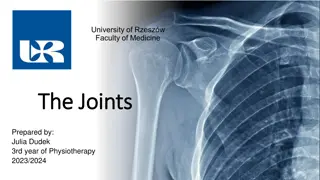Overview of Foot Joints and Bones: Anatomy and Movements
Foot anatomy involves 26 bones forming various joints like interphalangeal, metatarso-phalangeal, and tarso-metatarsal joints. Ligaments and movements at these joints play crucial roles in foot function. Understanding the structure and function of these joints is essential for medical professionals and students studying human anatomy.
Download Presentation

Please find below an Image/Link to download the presentation.
The content on the website is provided AS IS for your information and personal use only. It may not be sold, licensed, or shared on other websites without obtaining consent from the author.If you encounter any issues during the download, it is possible that the publisher has removed the file from their server.
You are allowed to download the files provided on this website for personal or commercial use, subject to the condition that they are used lawfully. All files are the property of their respective owners.
The content on the website is provided AS IS for your information and personal use only. It may not be sold, licensed, or shared on other websites without obtaining consent from the author.
E N D
Presentation Transcript
JOINTS OF FOOT By Dr. AMBER RANA JR 3 Department Of Anatomy KGMU
Joints of Foot Joints of Foot Name of bones of foot Names of different types of joints in foot Type of joints Ligaments attached to the bones formin joints Action at these joints
Foot comprises of the following bones from before backwards: Phalanges distal , middle, proximal (14) Metatarsals- (5) Cuneiform- Medial , intermediate and lateral(3) Cuboid- (1) Navicular (1) Talus (1) Calcaneum-(1) Making a total of 26 bones.
Joints that are formed by these bones from before backwards are: 1. Interphalangeal joints 2. Metatarso-phalangeal joints 3. Tarso-metatarsal joints 4. Intertarsal joints- Subtalar Talo-calcaneo-navicular Calcaneo-cuboid Articulations of intermediate and lateral cuneiform bones with the bases of 2ndand 3rd metatarsal bones Adjacent surfaces of the bases of 2nd, 3rd, and 4th metatarsal bones Between the medial cuneiform and the base of 1stmetatarsal bones Between the cuboid and the bones of 4thand 5thmetatarsal bones 5. Mid tarsal or transverse tarsal joint 6. Talo-calcaneo-navicular joint 7. Calcaneo-cuboid joint
INTERPHALANGEAL JOINT TYPE- type of typical hinge joints and each possesses capsular ligament and collateral ligament . Movement- dorsi-flexion plantar flexion proximal interphalangeal joints are endowed with greater range of movement
Metatarso-phalangeal joints Type- Ellipsoid type of synovial joints Ligaments- capsular, collateral, plantar, and deep transverse metatarsal ligament. The collateral ligament are 2 in number present on either side of each joint. Deep transverse ligament are 4 in number and connects the planter ligament of metatarso-phalangeal joint. Articular surfaces- the head of first meta-tarsal is convex and the base of the proximal phalanx is reciprocally concave. Movement at this joint- dorsi-flexion(50-60 degree), planter-flexion(30-40 degree), adduction and abduction. Adduction and abduction are with reference to the axis passing through the 2 toe, because the 2ndtoe is the least mobile.
Tarso-meta tarsal joints Total 5 in number Type- plane synovial joint. Ligaments- Dorsal, planter and interosseous cuneo-metatarsal ligaments. 1st tarso-metatarsal ligament is a separate joint cavity. 2ndand 3rdmetatarsal join to form another joint cavity 4thand 5thagain join to form a separate joint cavity. Movement- gliding movement.
Intertarsal joint Type- Synovial joint Number- 6 Formed between- 3 cuneiform bone, lateral cuneiform and cuboid Names of 6 intertarsal joints are- a) Subtalar b) talo-calcaneo-navicular c) calcaneo-cuboid d) a joint cavity comprising cuneo-navicular, inter-cuneiform, cuneio-cuboid,intermediate and lateral cuneiform bones with base of 2ndand 3rd meta-tarsal bones, adjacent surfaces of 2nd,3rdand 4thmetatarsal bones e) medial cuneiform and base of 1stmetatarsal bones f) between cuboid and 4thand 5th meta- tarsal bones
Mid-tarsal joints 2 in number One is medial joint cavity : talo-calcaneo-navicular 2ndis lateral joint cavitiy: calcaneo-cuboid joint Both components are connected by the bifurcated ligament and move as one unit during inversion and eversion of the foot Talo-calcaneo-navicular joint- Ball and socket joint. Articular surfaces- spheroidal head of talus (ball) concave posterior surface of navicular (socket) upper surface of the plantar calcaneonavicular ligament and the 2 talar facets on the upper surface of the sustentaculum tali of calcaneus
The ligaments of this joint are- capsular ligament, talo-navicular, plantar calcaneo-navicular (spring ligament), and calcaneo-navicular part of bifurcated ligament Capsule ligament loosely envelops the joint . Talo- navicular ligament covers the capsule and connects the dorsal surface of navicular and neck of talus Spring ligament- connects plantar surface of navicular with sustanteculum tali of calcaneus. Permanent stretching of the ligament produces flat foot
Calcaneo-cuboid joint Type- saddle or sellar joint. Articular surfaces: concavo-convex type between calcaneous and posterior surface of the cuboid. Ligaments: articular capsule, bifurcated ligaments, short and long plantar ligaments. The capsular ligament envelopes the joint and is strengthened on its dorsal surface by the dorsal calcaneocuboid ligament.
Subtalar joint Type- modified multi-axial synovial joint Also known as posterior talo-calcaneal joint. Formed between the obliquely placed concave articular facet at the lower surface of body of talus and convex articular of calcaneum. Ligaments- Capsular, medial and lateral talo-calcanean, interosseous talo- calcanean, and cervical ligament. Action- inversion and eversion of foot.
THANKYOU THANKYOU























